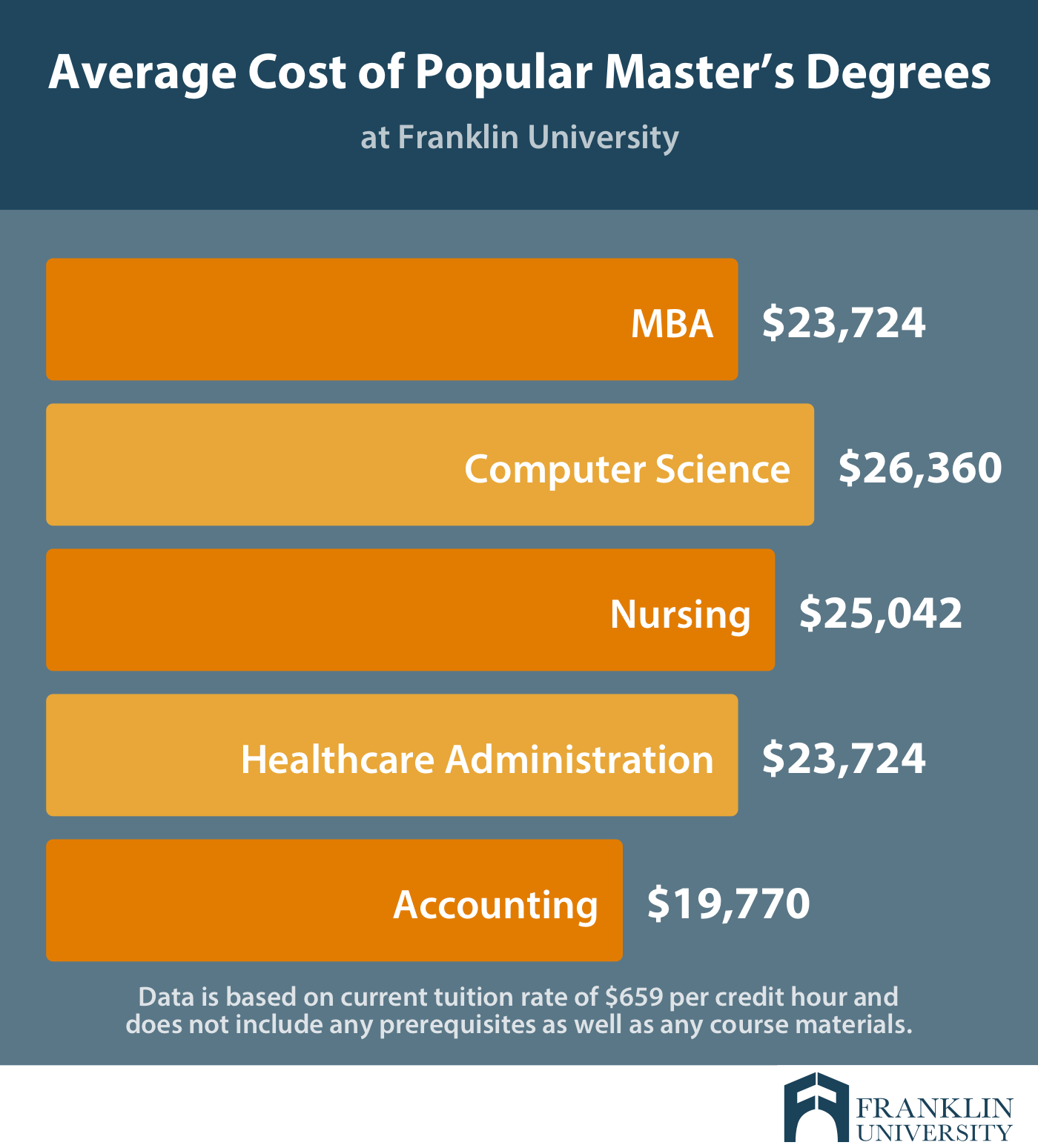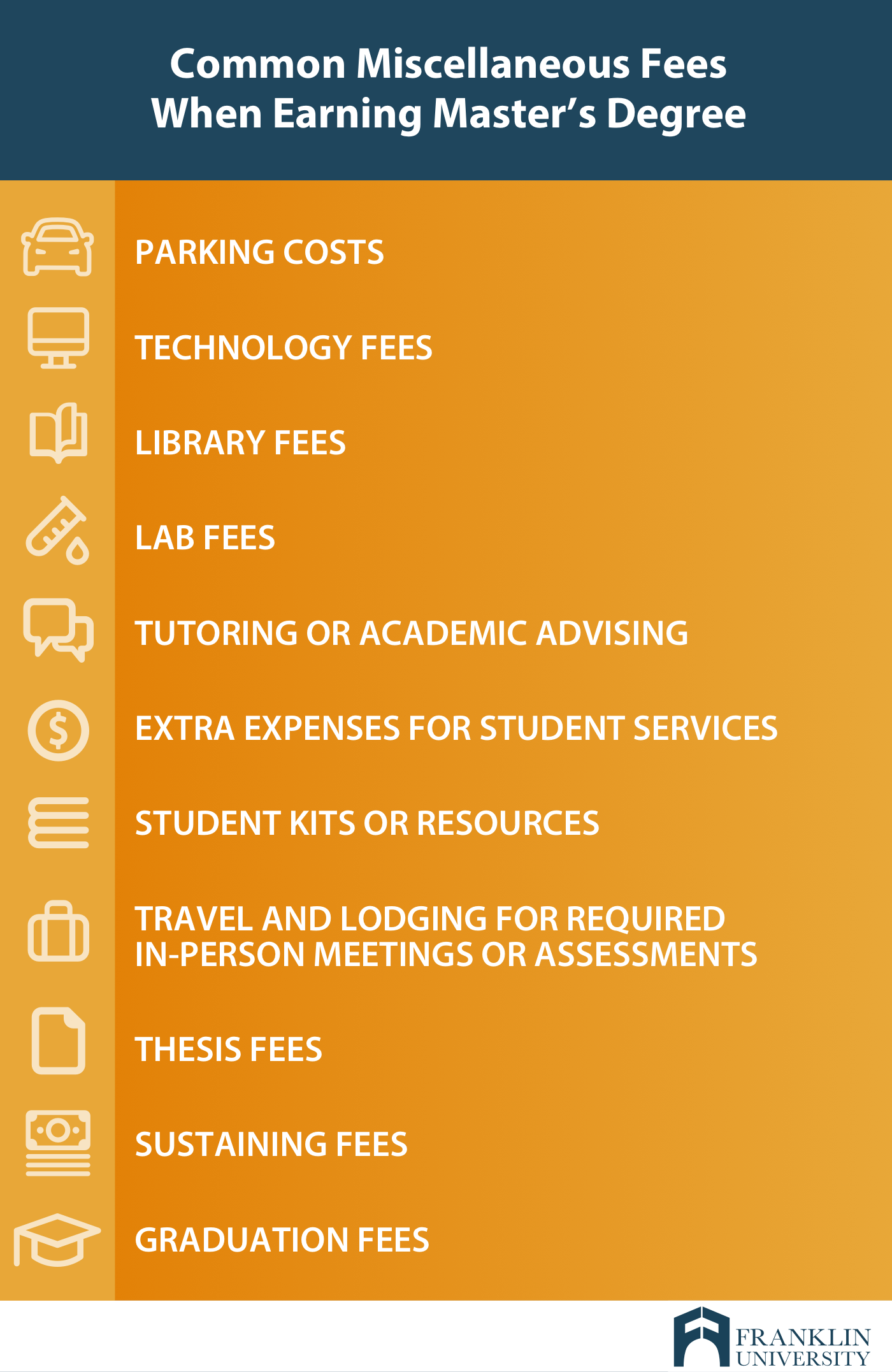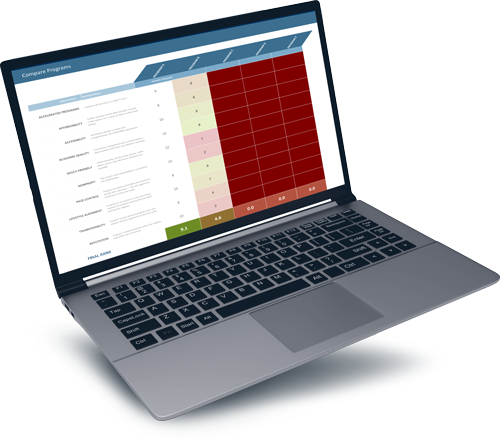Request Information
We're Sorry
There was an unexpected error with the form (your web browser was unable to retrieve some required data from our servers). This kind of error may occur if you have temporarily lost your internet connection. If you're able to verify that your internet connection is stable and the error persists, the Franklin University Help Desk is available to assist you at helpdesk@franklin.edu, 614.947.6682 (local), or 1.866.435.7006 (toll free).
Just a moment while we process your submission.

The Cost of a Master’s Degree: 8 Drivers Within Your Control
The cost of graduate schools can be hard to compare, and some schools are guarded on the topic of hidden or incidental costs. Are you comparing programs to see if you’re getting a value or if you’re going to feel overcharged?
Before you get started, let us introduce you to some of the noteworthy influences on costs and how you can reduce them.
What Is the Average Cost?
The latest averages for completing an accredited master’s program begin around $30,000 or $40,000 for a typical public or private school. Those costs can approach $100,000 or more for high-end graduate schools that offer name-dropping prestige.
Tuition and fees are common costs that every school will clearly list in their materials. Check to see if the fees are a flat cost or if they might be a more costly fee that is calculated per credit.
The truth is that the real cost of a graduate degree varies significantly by program.

To find cost-effective programs, start by knowing what the cost drivers are. Then you can be a smart consumer and put your top schools through their paces. Here is a helpful list of items that drive the cost of a graduate program.
What Drives the Cost?
The total price of a degree is comprised of lots of different costs. And identifying those costs can be the key to saving money. Below are eight common cost drivers that may have more or less influence on your decision, depending on your own situation and choices.
1. Profit vs Not-for-Profit Schools
You might first want to consider the difference between profit-based schools and not-for-profit schools. For-profits (sometimes called “proprietary schools”)
Profit institutions
- are in business to make money for owners and shareholders by offering a service (in this case, education)
- must provide adequate financial returns for their shareholders and stakeholders; making a profit is an absolute priority
Non-profit institutions
- offer a learning environment designed first and foremost to serve students’ interests, helping them finish their college degrees and achieve career success
- operate independently of an owner structure and are free to focus on providing quality education to students
This article can give you some more insight about the differences between profit and not-for-profit programs.
What matters most when choosing a master’s program? Compare features, benefits and cost to find the right school for you.
2. Online Only vs On-Campus or Hybrid
Logic might suggest that online coursework could present a cost savings in terms of a school having less brick-and-mortar costs and upkeep. However, current trends have many schools charging more for the convenience of their online programs.
Work with your school to understand the costs of their program options. While an online course may have a higher sticker price, the savings in transportation and parking could more than make up for it.
3. Application Requirements & Fees
On average, application fees cost around $100. However, some programs have higher fees. You may also be required to pay for additional testing to confirm your readiness to attend. Some schools may require you to take the GMAT (Graduate Management Admission Test) or the GRE (Graduate Record Examination), depending on your school and your discipline. Such testing will add to the cost of applying to that school. Ask about any miscellaneous processing fees that may be a part of your application. Also, in some programs, like computer science, you may need to enroll in and pay for additional foundational coursework as a prerequisite before you begin your master’s work.
4. Miscellaneous Student Fees
With some schools, it seems as if every time you turn around, they’re asking you for a little fee for this or that. If you don’t plan for these incidental costs, you will be surprised at how quickly these can add up.

And, of course, tuition increases could be considered a surprise fee that you didn’t exactly plan for. Depending on the school, you might discover that these miscellaneous fees can add up to several hundred dollars each year. At Franklin, we know how hidden fees can be frustrating and difficult to plan for, which is why we have eliminated them wherever possible. You can find a transparent listing of our costs and fees here.
5. Books & E-texts
To reduce college expenses and increase convenience, some schools are adopting electronic textbooks and using fewer, if any, physical books. Downloadable e-books are especially convenient, since they can be accessed on a variety of devices, including desktop computers, laptops, tablets, or smartphones. Most courses require the purchase of one major e-book, typically with a price tag of $60 to $100. (You will likely find necessary books on the school’s website, similar to how they’re shown on this Franklin University e-book list.) There are courses that will have more or less expensive books, but the key is for you to understand up front what costs to expect at your chosen school over the course of all of your classwork.
6. The Heritage of a Program
When a student chooses to pay $100,000 to $120,000 for an MBA from Harvard, Yale or Wharton, it’s often because of the program’s respected, long-standing heritage and its anticipated value in a lifetime of networking connections.
Some of these school names will open doors and create opportunities. But for most people in most industries, having a Harvard degree isn’t really that critical. It’s all about understanding your industry and where you want to work.
7. Transfer Credit Policies
Sometimes, students will have previous master’s-level coursework, widely recognized industry or professional credentials, or high-level work experience that may qualify them to receive credit toward their current graduate studies. Not every school will consider transferring credit in this way. If your school does transfer in some course credit, then that will lower the time and the cost needed to get your degree. The best advice is to work with your admissions advisor to explore transfer opportunities.
8. Subject of Study
The actual subject you choose to study will also influence your total cost.
Some areas of study simply require more coursework, which means you will need to attend maybe one or two more semesters than another subject of study. When you need to earn 40 credit hours instead of 36 credit hours, it just takes extra time--and cost. And it’s not just about the cost per credit hour; you must consider the cost of transportation, parking, student fees and more as you attend those additional semesters.
It’s also true that not every subject is available at every school. Certain subjects may only be instructed at a limited number of schools, and that can carry a premium price.
Comparing Apples to Apples
Before you get too deep into your analysis of your top two or three graduate schools, you may want to take an extra step to calculate your comparisons by cost per credit hour. Then you’ll have a more accurate idea if you’re getting a good deal. Of course, for a full 360-degree view, you should take into account all the other items listed above. Talk with your admissions advisors at the different schools on your shortlist, take good notes, and you’ll soon have a much clearer picture of what program will be your best value.
Now you know that some price drivers are actually within your control. By doing your homework up front and choosing the right program, it’s still possible for you to get your master’s at a reasonable and affordable price.





